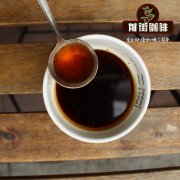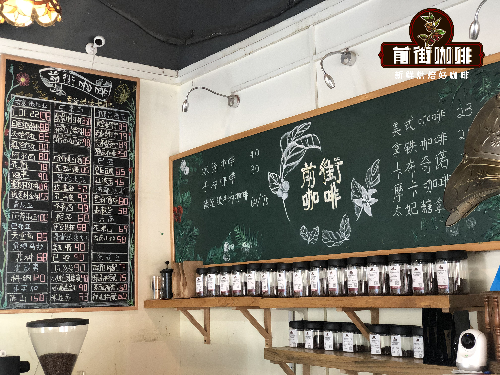Coffee beans three types of Arabica types of iron pickup Bourbon rose summer coffee varieties difference

Professional coffee knowledge exchange more coffee bean information please follow the coffee workshop (Wechat official account cafe_style)
What are the three categories of coffee tree beans in the world? What kind of coffee beans are suitable for planting?
Coffee tree is a genus of Rubiaceae in botany. The classification of coffee trees is very complex, there are many species, diversity and varieties. Different varieties of coffee beans have different tastes, but even the same varieties of coffee trees have their own unique flavor due to the influence of different soils and different climates.
The coffee production belt is between 25 degrees north latitude and 30 degrees south latitude. Because coffee trees are vulnerable to frost, the tropics are the most suitable. The average annual temperature in this area is 15 °C, and the slopes with abundant rainfall and good drainage of 1500--2000mm, coupled with planting other tall trees to shade the wind, are more suitable for the growth of coffee trees.
There are about 60 species of coffee plants in the world, and only 25 species are artificially cultivated for making coffee, of which three are the most important ones used as commercial coffee:
Arabica (Coffea arabica), Robasta (Coffea Robusta), Laibirika (Coffea liberica).
Arabica (Coffea arabica):
Characteristics:
The oldest and most commercially practical coffee beans with a variety of complex species
Planting method:
They like mild days and cooler nights, and a climate that is too cold, too hot and too humid can be fatal to it.
Elaraby needs to plant coffee trees on sloping slopes above 900m above sea level, so harvesting must be carried out manually, which is extremely difficult. However, due to the excellent aroma, balanced taste and low caffeine content (1.1-1.7%) of Elaraby coffee beans, although it is not easy to grow, it actually accounts for about 75% of the total coffee planted.
Arabica (Arabica): premium coffee beans with excellent flavor and aroma
Arabica is a representative variety of Ethiopia of origin, and it is also produced in South Africa, Africa, Asia and other countries, accounting for 70% of the world's coffee production. Arabica has weak resistance to diseases and insect pests, so the highland area is more suitable for cultivation, especially the quality of Arabica coffee beans produced in the highland above 1500 meters is the best.
The good quality produced by the effort like this, with a balanced flavor, taste and aroma, can be certified as high-grade coffee beans, mainly used in individual coffee or boutique coffee. The three well-known coffee beans: Kona in Hawaii, Blue Mountain in Jamaica and Moka in Yemen, belong to the Arabica variety. Arabica raw beans have a dark, narrow appearance, known as the highest quality of high-quality Arabica varieties, characterized by sweet, sour and aroma and other rich flavor.
* * Coffea Robusta:
Characteristics:
The one with the highest yield has more personality in taste and is often used for blending or instant coffee.
Planting method:
It has strong resistance to tropical climate, high temperature, cold resistance, moisture resistance, drought resistance, and even mold infestation. It has strong adaptability, can grow very well on flat land, and grows very well at an altitude of 200-300 meters. Harvesting does not necessarily require manual work, but can be carried out entirely by vibration machines. As far as planting is concerned, Robasta has many advantages in growing coffee trees, but it is a pity that the coffee beans produced are bad in aroma, strong in bitterness, insufficient in acidity, and the caffeine content is twice that of Arabica, which currently accounts for about 25-30% of the world's coffee production.
Robusta is of African origin and accounts for 30% of the world's coffee production. The word Robusta means "tenacity". In fact, this kind of coffee tree is not only resistant to diseases and insect pests, but can survive in any soil, even in the wild. Therefore, it can also be planted in high temperature areas, growing fast and easy to cultivate, and has the advantage of low price, which is mainly used to mix beans or make instant coffee as the main raw material. Some Robusta produced in India, Africa, Brazil and other places have a strong sour taste, high caffeine content and rich taste. Recently, there are also varieties of Arabusta, which mate with Arabica varieties and have better taste and aroma.
The appearance of Robusta is bulging oval, and raw beans are light brown or yellowish brown with grass green and yellow luster. Compared with Arabica varieties, the taste is more fragrant and lighter, with less sour taste and more bitter taste.
* * Coffea liberica:
Characteristics:
It's a bit of Robastar, and it usually doesn't taste very good.
Planting method:
Less affected by rainfall and temperature, planted below 200 meters above sea level, originated in Liberia, widely distributed, strong tolerance, but poor quality, strong bitterness, poor aroma, so it is not taken seriously, and the planting amount is the least.
Therefore, at present, Arabica and Robasta are the main types of coffee in the world.
Arabica coffee beans are green to light green in color, oval in shape and curved in grooves.
Robastian coffee beans are round in shape, brown in color and with straight grooves.
[growth process of coffee trees] Seeds: that is, mature coffee bean sprouts: after coffee beans are dropped or sown artificially, the seedlings sprout for about 1-2 months: that is, the sprouting period of the seedlings is about 1-4 years. Fruit trees: trees that begin to blossom and bear fruit from about the fifth year: about 20-25 years [formation process of coffee fruit]
White flowers (spring): White flowers bloom three times a year from January to April. The flowers are white tubular with a faint fragrance of jasmine.
Green fruit (summer): White flowers will be withered in about a week, and small green fruits begin to appear.
Yellow fruit (autumn): after the green fruit is full for about 4 months, the pericarp begins to turn yellow
Red fruit (winter): yellow fruit after about a month, the pericarp gradually turn red, to crimson harvest, when the fruit size, color, shape are similar to cherries, so coffee fruit is also called Cherry, under the red peel, there will be a layer of sweet mucus wrapped coffee beans, under normal circumstances, each fruit will have two coffee beans.
Important Notice :
前街咖啡 FrontStreet Coffee has moved to new addredd:
FrontStreet Coffee Address: 315,Donghua East Road,GuangZhou
Tel:020 38364473
- Prev

What are the advantages of Arabella and Robusta, the big categories of world coffee beans? The common Arabica
Professional coffee knowledge exchange more coffee bean information please follow the coffee workshop (Wechat official account cafe_style) the world coffee bean classification of Arabella and Robusta advantages? How many kinds of Arabica are common? The world's three major coffee varieties are relatively brief: one. Types of coffee: coffee beans can be roughly divided into three categories: (1) Arabica (Arab)
- Next

Introduction to the characteristics of Arabica Rosa Iron Card Coffee beans is Robusta Coffee beans delicious?
Professional coffee knowledge exchange more coffee bean information please follow the coffee workshop (Wechat official account cafe_style) there are too many varieties of coffee beans to distinguish! How to classify the three major varieties of coffee beans in the world? What is the difference between planting, flavor and taste? From a botanical point of view, coffee belongs to the genus Rubiaceae, and there are many varieties below, and we usually drink it into our mouths.
Related
- Detailed explanation of Jadeite planting Land in Panamanian Jadeite Manor introduction to the grading system of Jadeite competitive bidding, Red bid, Green bid and Rose Summer
- Story of Coffee planting in Brenka region of Costa Rica Stonehenge Manor anaerobic heavy honey treatment of flavor mouth
- What's on the barrel of Blue Mountain Coffee beans?
- Can American coffee also pull flowers? How to use hot American style to pull out a good-looking pattern?
- Can you make a cold extract with coffee beans? What is the right proportion for cold-extracted coffee formula?
- Indonesian PWN Gold Mandrine Coffee Origin Features Flavor How to Chong? Mandolin coffee is American.
- A brief introduction to the flavor characteristics of Brazilian yellow bourbon coffee beans
- What is the effect of different water quality on the flavor of cold-extracted coffee? What kind of water is best for brewing coffee?
- Why do you think of Rose Summer whenever you mention Panamanian coffee?
- Introduction to the characteristics of authentic blue mountain coffee bean producing areas? What is the CIB Coffee Authority in Jamaica?

